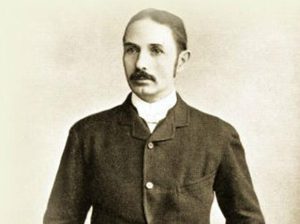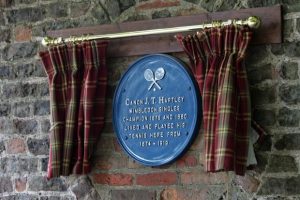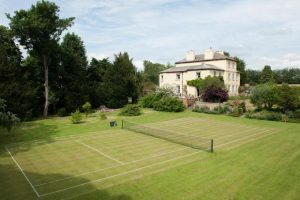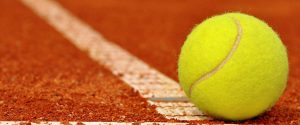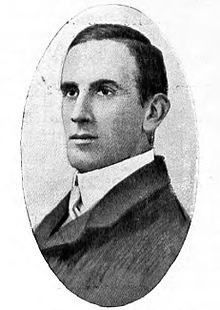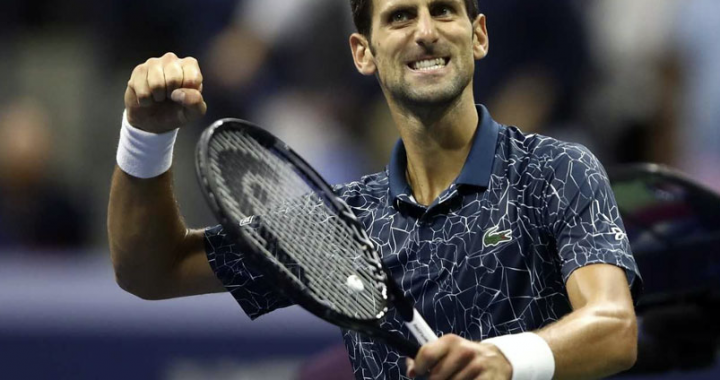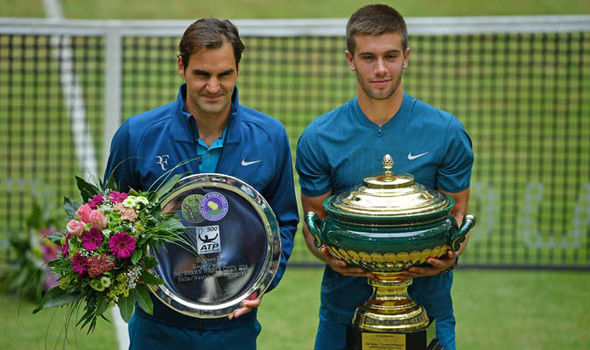The 1877 Wimbledon Championship was held at the All England Croquet and Lawn Tennis Club (AEC & LTC) in Wimbledon, London. It was the world’s first official lawn tennis tournament, and was later recognised as the first Grand Slam tournament or “Major”. The AEC & LTC had been founded in July 1868, as the All England Croquet Club; lawn tennis was introduced in February 1875 to compensate for the waning interest in croquet. In June 1877 the club decided to organise a tennis tournament to pay for the repair of its pony roller, needed to maintain the lawns. A set of rules was drawn up for the tournament, derived from the first standardised rules of tennis issued by the Marylebone Cricket Club in May 1875.
The Gentlemen’s Singles competition, the only event of the championship, was contested on grass courts by 22 players who each paid one guinea to participate. The tournament started on 9 July 1877, and the final – delayed for three days by rain – was played on 19 July in front of a crowd of about 200 people who each paid an entry fee of one shilling. The winner received 12 guineas in prize money and a silver challenge cup, valued at 25 guineas, donated by the sports magazine The Field. Spencer Gore, a 27-year-old rackets player from Wandsworth, became the first Wimbledon champion by defeating William Marshall, a 28-year-old real tennis player, in three straight sets in a final that lasted 48 minutes. The tournament made a profit of £10 and the pony roller remained in use. An analysis made after the tournament led to some modifications of the rules regarding the court dimensions.
The first public announcement of the tournament was published on 9 June 1877 in The Field magazine under the header Lawn Tennis Championship:
The All England Croquet and Lawn Tennis Club, Wimbledon, propose to hold a lawn tennis meeting, open to all amateurs, on Monday, July 9th and following days.[l] Entrance fee, £1 1s 0d. Names and addresses of competitors to be forwarded to the Hon. Sec. A.E.C. and L.T.C. before Saturday, July 7, or on that day before 2.15 p.m. at the club ground, Wimbledon. Two prizes will be given – one gold champion prize to the winner, one silver to the second player. The value of the prizes will depend on the number of entries, and will be declared before the draw; but in no case will they be less than the amount of the entrance money, and if there are ten and less than sixteen entries, they will be made up to £10 10s and £5 5s respectively.– Henry Jones – Hon Sec of the Lawn Tennis sub-committee
Players were instructed to provide their own racquets and wear shoes without heels. The announcement also stated that a programme would be available shortly with further details, including the rules to be adopted for the meeting. Invitations were sent to prospective participants. Potential visitors were informed that those arriving by horse and carriage should use the entrance at Worple Road while those who planned to come by foot were advised to use the railway path. Upon payment of the entrance fee, the participants were allowed to practise before the Championship on the twelve available courts with the provision that on Saturdays and during the croquet championship week, held the week before the tennis tournament, the croquet players had the first choice of courts. Practice balls, similar to the ones used for the tournament, were available from the club’s gardener at a price of 12s per dozen balls. John H. Walsh, in his capacity as editor of The Field, persuaded his employer to donate a cup worth 25 guineas for the winner; the Field Cup. The cup was made of sterling silver and had the inscription: The All England Lawn Challenge Cup – Presented by the Proprietors of The Field – For competition by Amateurs – Wimbledon July 1877. On 6 July 1877, three days prior to the start of the tournament, a notice was published in The Times:
Next week at the All England Croquet and Lawn Tennis Club Ground a Lawn Tennis Championship Meeting will be held. The ground is situated close to the Wimbledon Station on the South Western Railway, and is sufficiently large for the erection of thirty “courts”. On each day the competition will begin at 3.30, the first ties, of course, beginning on Monday. The Hon. Sec. of the meeting is Mr. J.H. Walsh, while Mr. H. Jones will officiate as referee. The entries are numerous.
In accordance with the All England Regulations for the Management of Prize Meetings, the draw for the 22 entrants was made on Saturday, 7 July 1877, at 3:30 p.m. in the club’s pavilion. H.T. Gillson had the distinction of being the first player in the history of modern tennis to be drawn for a tournament. The posts, nets and hand-stitched, flannel-covered India-rubber balls for the tournament were supplied by Jefferies & Co from Woolwich, while the rackets used were an adaptation of those used in real tennis, with a small and slightly lopsided head. The ball-boys kept the tennis balls, 180 of which were used during the tournament, in canvas wells. The umpires who were provided for the matches sat on chairs which in turn were placed on small tables of 18 inches height to give them a better view of the court.
The tournament began on Monday, 9 July 1877, at 3:30 p.m. and daily programmes were available for sixpence. On the first day, in sunny weather, ten matches were played, which completed the first round. Full match scores were published on the notice board inside the pavilion. F.N. Langham, a Cambridge tennis blue, was given a walkover in the first round when C.F. Buller, an Etonian and well-known rackets player, did not appear. Julian Marshall became the first player to win a five-set match when he fought back from being two sets down against Captain Grimston. Spencer Gore, a 27-year-old rackets player from Wandsworth and at the time a land agent and surveyor by profession, won his first round match against Henry Thomas Gillson in straight sets. The five second-round matches were played on Tuesday, 10 July, again in fine weather. Charles Gilbert Heathcote had a bye in the second round. J. Lambert became the first player in Wimbledon Championships’ history to retire a match, conceding to L.R. Erskine after losing the first two sets. Julian Marshall again won a five-set match, this time against F.W. Oliver, while Gore defeated Montague Hankey in four sets.
The quarter-finals were played on Wednesday, 11 July, before a larger number of spectators than had attended the previous matches. Start of play was delayed from the scheduled 3:30 p.m. due to strong winds. Gore defeated Langham in four sets, William Marshall beat Erskine, also in four sets, and Julian Marshall, who injured his knee during the match after a fall, lost to Heathcote in straight sets. The quarter-final matches left three players, instead of four, in the draw for the semi-finals scheduled for Thursday. To solve the situation lots were drawn and Marshall, a 28-year-old architect and Cambridge real tennis blue, was given a bye to the final. His opponent would be Gore, who defeated Heathcote in straight sets in the only semi-final played. When the semi-final stage had concluded on Thursday, 12 July, play was suspended until next Monday, 16 July, to avoid a clash with the popular annual Eton v Harrow cricket match that was played at Lord’s on Friday and Saturday.
The final was postponed from its scheduled start on Monday at 4 p.m. until Thursday, 19 July, at 3:30 p.m. because of rain. On Thursday it was still showery, causing the final to be further delayed by an hour. It began on a dead and slippery court in front of about 200 spectators. There was a temporary three-plank stand on one side of the court offering seating to about thirty people. Marshall won the toss, elected to serve first and was immediately broken by Gore. After the first set was won by Gore, it started to rain for a quarter of an hour; this further softened the ground and affected the quality of play. The final lasted 48 minutes, and Spencer Gore won the inaugural championship against William Marshall in three straight sets of 15, 13, and 20 minutes respectively. En route to the title Gore had won 15 sets and lost two and won 99 games for the loss of 46. Gore, the volley specialist, had beaten the baseline player, at a time when volleying was considered by some to be unsporting. Some tried to outlaw the volley and a discussion on its merits took place in The Field for weeks after the tournament.
The final was followed by a play-off match for 2nd place between Marshall and Heathcote. The players could not fix another date for the match and decided to play it straight away. By agreement, the match was limited to best-of-three sets. Marshall, playing his second match of the day, defeated Heathcote in straight sets, in front of a diminished crowd, and won the silver prize of seven guineas.
On 20 July 1877, the day following the final, a report was published in The Morning Post newspaper:
Lawn Tennis Championship – A fair number of spectators assembled yesterday, notwithstanding the rain, on the beautifully kept ground of the All England Club, Wimbledon, to witness the final contest between Messrs. Spencer Gore and W. Marshall for the championship. The play on both sides was of the highest order and its exhibition afforded a great treat to lovers of the game. All three sets were won buy Mr. Gore, who, therefore, becomes lawn tennis champion for 1877, and wins the £12 12s. gold prize and holds the silver challenge cup, value £25 5s. The second and third prizes were then played for by Messrs. W. Marshall and G.C. Heathcote (best of three sets by agreement). Mr. Marshall won two sets to love, and therefore takes the silver prize (value £12 12s.). Mr. Heathcote takes the third prize, value £3 3s.
A report in The Field stated: “The result was a more easy victory for Mr Spencer Gore than had been expected.”. Third-placed Heathcote said that Gore was the best player of the year and had a varied service with a lot of twist on it. Gore, according to Heathcote, was a player with an aptitude for many games and had a long reach and a strong and flexible wrist. His volleying style was novel at the time, a forceful shot instead of merely a pat back over the net. All the opponents who were defeated by Gore on his way to the title were real tennis players. His victory was therefore regarded as a win of the rackets style of play over the real tennis style, and of the offensive style of the volley player – who comes to the net to force the point, over the baseline player – who plays groundstrokes from the back of the court, intent on keeping the ball in play. His volleying game was also successful because the height of the net at the post – 5 ft (1.52 m) in contrast to the modern height of 3 ft 6 in (1.07 m) – made it difficult for his opponents to pass him by driving the ball down the line. Gore indicated that the real tennis players had the tendency to play shots from corner to corner over the middle of the net and did so at such a height that made volleying easy.
Despite his historic championship title, Gore was not enthusiastic about the new sport of lawn tennis. In 1890, thirteen years after winning his championship title, he wrote: “… it is want of variety that will prevent lawn tennis in its present form from taking rank among our great games … That anyone who has really played well at cricket, tennis, or even rackets, will ever seriously give his attention to lawn tennis, beyond showing himself to be a promising player, is extremely doubtful; for in all probability the monotony of the game as compared with others would choke him off before he had time to excel in it.” He did return for the 1878 Championship to defend his title in the Challenge Round but lost in straight sets to Frank Hadow, a coffee planter from Ceylon, who effectively used the lob to counter Gore’s net play. It was Gore’s last appearance at the Wimbledon Championships.
The tournament generated a profit of £10 and the pony roller stayed in use. When the tournament was finished, Henry Jones gathered all the score cards to analyse the results and found that, of the 601 games played during the tournament, 376 were won by the server (“striker-in”) and 225 by the receiver (“striker-out”). At a time when the service was either made underarm or, usually, at shoulder height, this was seen as a serving dominance and resulted in a modification of the rules for the 1878 Championship. To decrease the target area for the server, the length of the service court was reduced from 26 to 22 ft (7.92 to 6.71 m) and to make passing shots easier against volleyers the height of the net was reduced to 4 ft 9 in (1.45 m) at the posts and 3 feet (0.91 m) at the centre. These rules were published jointly by the AEC & LTC and the MCC, giving the AEC & LTC an official rule-making authority and in effect retroactively sanctioning its 1877 rules. It marked the moment when the AEC & LTC effectively usurped the rule-making initiative from the MCC although the latter would still ratify rule changes until 1882. In recognition of the importance and popularity of lawn tennis, the club was renamed in 1882 to All England Lawn Tennis Club (AELTC).
(Source: Wikipedia)
In Part 2 we will take a closer look at who those first 22 contestants in 1877 were.
